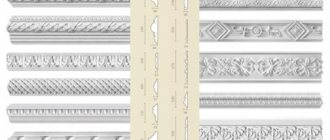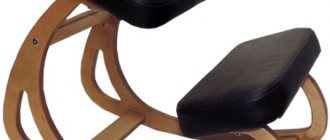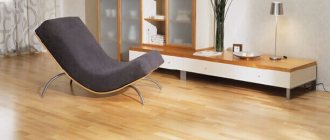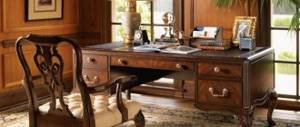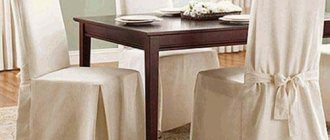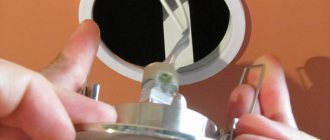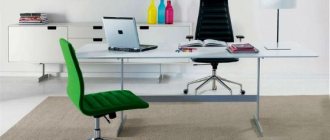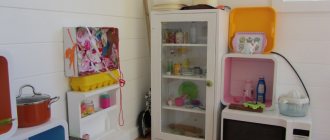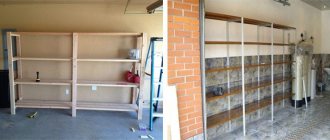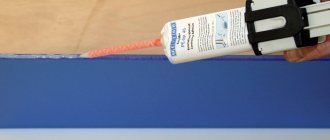Chairs made from solid natural wood are a stylish and functional element of the furnishings of a house or apartment. They are environmentally friendly and have a fairly reliable and durable design, and their only drawback is that they are assembled from separate parts connected to each other with spikes or dowels, set in grooves with glue. Over time, this connection dries out, so the chair begins to wobble and creak. It can be repaired by re-gluing the “loose” parts. Let's take a closer look at how to glue a wooden chair at home.
Video material
That's the whole process of gluing chairs, which will quite simply help you get rid of swaying and creaking furniture. If the tenon joints of the chairs are sufficiently damaged or the grooves become much smaller, it is necessary to increase them. For help in this matter, you can contact a professional workshop.
Wooden furniture has always been held in high esteem and to this day remains a source of pride for owners. However, nothing lasts forever and everything falls into disrepair one day. Our specialists have sufficient experience in the repair and restoration of wooden furniture and will tell you how to glue a wooden chair together.
Stripping tenon joints
Before you start gluing the chairs, clean all connecting areas of old glue. To make it much easier to scrape off, apply warm vinegar or a small amount of solvent, then remove all residue from the surface.
On some upholstered chairs, the seat panels are not tightly connected to the frame, and as a result, it loses the necessary stability. This defect can be eliminated if triangular or trapezoidal solid wood chocks are tightly screwed to the frames that form the internal corners of the frame. This will strengthen the frame, it will remain stable even if the chair, for example, tips over or begins to be moved.
If the chair is used frequently and is heavily loaded, the reinforcements may also become loose. In this case, replace the old screws with new ones: they should be slightly thicker than before.
Drill holes in the corner chocks and frames so that the heads of the screws sink into them.
For corner chocks, choose screws of such length that they, without going through the frame, provide sufficient strength to the joint.
It is better to cut a new log from well-dried hardwood.
A careful inspection of the old chocks will help you determine whether they need to be replaced or whether it is enough to scrape off the old glue and apply fresh glue, and then screw in new screws. Be sure to replace cracked or split logs with new ones, which must be cut out of hard wood exactly according to the shape of the old ones, then glued into the drawer frame and screwed with screws.
Adhesive joints must be secured with clamps, clamps or cords until the glue has completely dried.
The glue must dry under pressure. Therefore, it is recommended to tighten the newly glued frame using clamps, clamp vices or cords and keep it that way for about 12 hours. At the same time, you should not create too much pressure, otherwise a lot of glue will leak out of the grooves. After some time, loosen the tension a little.
Make sure that when tensioning, the chair frame is at the correct angle and is not distorted. This requirement is easy to fulfill when repairing ordinary chairs. The situation is more complicated, for example, with English chairs or rocking chairs. However, at least the front of the chair can be controlled using a plumb line.
How to glue a wooden chair yourself
I would like to immediately note that gluing a wooden chair, although a feasible task, requires a painstaking approach and time. It will not be enough to simply buy any glue at the nearest store and use it to connect the broken parts, as many believe. Due to its structure, wood requires a special approach to repair.
One of the features of old-style wooden chairs is their structural composition, which includes many individual parts. They, in turn, are connected with glue, which is where the problem lies. Over time, the composition weakens or the joints become loose, although the individual elements of the chair retain functionality.
How to glue a chair with your own hands
To glue a chair, you must, in addition to glue, have the following tools and devices:
- hammer with rubber nozzle;
- construction knife or chisel;
- sandpaper;
- clamp, press or tightening belts;
- a clean piece of scrap fabric.
Restoration work on a wooden chair should be carried out in the following sequence:
- disassemble the loose knot by removing it from the groove, even if to do this you have to separate other strong seams;
- remove the remnants of old glue from the tenon or dowel using a knife or chisel (if the glue is difficult to remove, steam it with water steam);
- thoroughly clean the axle of the leg (or other piece of furniture) with sandpaper and remove shavings and dust from it with a cloth;
- apply a thin layer of glue to the axle and, inserting the chair part into the groove, hammer it in until it stops with a hammer with a rubber tip;
- be sure to remove any excess glue with a cloth;
- Depending on the place of gluing, tighten the chair fragments with a clamp, belts or press with a press.
The time for complete hardening of PVA glue is 24 hours. After a day, you need to remove the tightening straps (remove the clamp) - and you can use the repaired chair. If you want your restored wooden chair to last as long as possible, buy only high-quality PVA glue from our store!
We suggest you familiarize yourself with How to remove traces of adhesive tape from plastic, how to remove remnants of double-sided (double) tape, what can and cannot be used to remove glue stains?
If you have wooden chairs in your home, then knowing how to glue them will be very useful. Of course, you can contact us in the workshop and we will do everything quickly and reliably, but many people want to do it themselves; at home, we will post instructions for them on how to independently glue solid wood chairs.
And so, preface. A wobbly chair is always unpleasant, a creaking sound and a feeling of insecurity in the piece of furniture underneath you. You’re just waiting for the chair to fold up and you’ll find yourself on the floor. And if there are guests in the house, would you risk letting them sit on such a chair? Children are another matter; a wobbly chair is a real attraction for them. In fact, such rocking literally destroys the wood in the connecting places, but more on that later.
In fact, there is nothing difficult about gluing a wooden chair; it does not require much effort and many tools. The reliability of the structure after the work you have done will depend on the quality of the glue used and your diligence.
Gluing the back of a chair using a clamp. The placed bars protect the varnish from damage and evenly distribute pressure on the sides.
What glue do you use to glue chairs?
The first question that arises is “How to glue wooden chairs together?” There are several answers to this question, and which glue you choose depends on your personal preferences.
PVA wood glue is very popular when gluing wood. When purchasing PVA, you must choose those types of glue that are suitable for gluing wood and furniture. Furniture properly glued with PVA is quite reliable and strong; the only drawback is the greatly varying quality of glue among manufacturers. We can recommend using PVA produced in the USA or Western Europe.
You can use other adhesives whose chemical composition is neutral. Neutrality of the chemical composition is necessary so that the wood does not change color or become deformed. For example, you can use Moment wood glue.
When restoring chairs, “Fish glue” can be used when gluing. It is made from fish remains and is therefore completely natural. The most common use is in antique furniture to preserve the authenticity of the piece.
We have been using PVA glue for many years and trust it, the main thing is to choose a high-quality and reliable manufacturer. Further instructions will be described using his example.
Thanks to the straps, you can secure several elements at once during re-gluing. In the photo there are 4 legs attached at the same time.
Stripping tenon joints
Before you start gluing the chairs, the connecting areas must be cleaned of old glue. To make it easier to scrape off, apply warm vinegar or a little solvent, then remove the residue from the surface.
Sealing chairs
After stripping the tenon joints, you can proceed to direct gluing. PVA takes quite a long time to dry; the time required for it to harden is indicated on the label. It is necessary to securely fasten the parts to be glued so that they are pressed against each other with sufficient pressure.
In order to securely fasten the parts to be re-glued, use a clamp or tension belts. To ensure that no traces are left on the varnished surface of the wood after this, it is necessary to use spacers. These can be wooden blocks or thick rubber, but fabric will not work.
You will need several clamps to secure all the parts. Using belts you can fasten several sides at once, which is very convenient. Check the tension of the belts and if they are loose, tighten them immediately.
This is how you can quite easily get rid of squeaking and swaying chairs. If the tenon joints of the chairs are severely damaged or have become much smaller than the groove, they need to be extended. For this procedure, you can contact our workshop. Good luck with your work!
We suggest you familiarize yourself with Small bites on the body that itch
When restoring furniture, you need to have not only high-quality parts, but also glue. The reliability of the design depends on this. Incorrectly selected products can ruin the appearance of the product and its functionality. The instructions do not always help you find out what material the glue is suitable for.
There are many types of glue, differing in color, consistency, and composition. There are suitable products for each material. If you select them correctly, the structure will be durable.
Leg gluing and complete repair
Dry stool is no longer a problem
The legs of a wooden chair can be glued with fresh glue that meets the specified characteristics. You should also stock up on a hammer with a rubber tip, sandpaper, a press and a chisel. Simple repairs are carried out in several stages:
- You should pull out the loose leg and clean the remaining old glue from the part where the product is loose.
- Fresh glue is applied to the leg, inserted back into the seat, and then sealed.
- It is necessary to place a press on the seat, remove the remaining glue and hold the parts to be glued for the time indicated on the glue packaging.
Dry chair 1. If only one leg is wobbly, having freed itself from the binding, you need to disassemble the binding so... 2. ... so that you can take out the cross member and clear its ends 3. Using a chisel, remove the remains of old glue and wood chips from the tenons of the binding and in the grooves of the chair leg 4. Only after this will the new adhesive joint hold. Apply glue to the grooves at the tenons, under the seat and spacers 5. Pull them horizontally, installing one clamp in the center, in the places of gluing, strapping and spacers. Gaskets will protect furniture
When asked how to glue a chair that has cracked in other places, you should first carefully disassemble the damaged parts. Repairing a chair with a drawer (frame connecting the legs of the chair) is considered difficult, since all the parts are glued and connected with a tenon groove. After disassembling the loose parts, it is necessary to clean the seams and apply glue to the joints. If the seam diverges, just drill a good hole and inject glue with a syringe.
If it is impossible to pull out the loose element, you should stretch the frame further and inject the adhesive into the groove. For strong stability, a narrow wedge can be inserted into the trunnion socket and secured with glue.
What glue to use
Craftsmen have different opinions about glue. There are many good adhesives from which you can choose the right one for a particular case.
Among the most effective:
- PVA glue. Most often used. However, you need to choose it wisely and a product from a stationery store will not work. When choosing, you should pay attention to the manufacturer. The composition from the USA or Europe is of decent quality. The only drawback of PVA is that it takes quite a long time to dry.
- Casein. It has the appearance of a light powder that dissolves with water to the consistency of thick sour cream. Characterized by high resistance to temperature fluctuations. The disadvantage of the composition is its visibility on the surface of the wood.
- Synthetic. It can be used without preliminary cleaning of the surface. Characterized by its moisture resistance, strength and resistance to low temperatures.
- Carpentry. Also a good composition for gluing wood. Its strength qualities depend on the quality of preparation and adherence to proportions when mixed with water.
There are a large number of special adhesives for wood on the market, among which the carpentry “Moment” can be noted.
What glue should I use for repair work?
If a wooden chair is broken, then it is recommended to use the best wood glue for repair. Nowadays the greatest demand is:
- "Kleyberite."
- "Moment" carpentry.
- "Trebond."
Professional carpenters put forward the following requirements for glue:
- It must be resistant to sunlight.
- Universal to use.
- The adhesive connection must be strong.
- It is recommended to use moisture-resistant glue.
- There should be no sticky residue left on the surface.
- Should not be toxic.
If you ask a professional craftsman how to glue a wooden chair, he will probably recommend using epoxy glue. It is best suited for wood products. PVA glue can be used. Some people use a two-component composition.
Directly re-gluing chairs
After you have cleaned the tenon joints, you can begin gluing directly.
Important! PVA glue takes quite a long time to dry, but fortunately the time required for it to harden is indicated on the label.
Proceed as follows to glue a wooden chair:
- Securely fasten all your glued parts so that they are pressed directly against each other with the necessary pressure.
- To securely fasten the glued parts, a clamp or special tension belts are used.
- To ensure that the varnished surface of the wood is not damaged after this and that no marks remain on it, be sure to use spacers.
Important! You can use wooden blocks or thick rubber as spacers, but fabric will not work.
- You will need a small number of clamps to secure all the parts. Using straps, you can secure several sides at the same time, which is incredibly convenient.
Important! Check the tension of all belts until the adhesive solution has completely cured. If they become loose, tighten them immediately.
Urea resin
Urea resin adhesive is prepared from thiourea or synthetic urea through a heating process. Such compositions create very strong compounds of wood products. They are resistant to moisture and can be used in extreme conditions.
This glue is acid-curing, and after mixing with a hardener its service life is short - up to 4 hours. It is used for hot pressing.
Reference! This glue is transparent, which is very beneficial when gluing wooden furniture.
Polyurethane glue
When high strength, resistance to liquids and mechanical loads are important, you can safely opt for polyurethane adhesive.
A well-known representative is Soudal 66 A, produced in Belgium. It can be used in harsh environments to bond wood products even if they are wet. It is compatible with most building materials.
We suggest you read: How to wash a car engine yourself
Reference! When hardened, the composition foams, which allows it to fill all seams and cracks.
Polyurethane wood adhesive mixture can be used for complex carpentry work indoors and outdoors. They love it for its excellent strength, water resistance, and reliable grip.
Kleiberit 501.0 is another polyurethane composition, but from a German manufacturer. This is a good universal furniture adhesive that is not afraid of high temperatures and moisture. Can be used when combining different materials.
The adhesive receives good reviews due to its convenient use, flawless connection and optimal consistency. When working with it, it is important to ventilate the room and protect the skin.
Softening old glue with steam
Steam flows from the kettle on the stove through a rubber or plastic hose to the socket in the chair. Hot water will flow down the tenon nest wrapped in a cloth. This way the remaining glue will dissolve faster.
To thoroughly strengthen a loose connection, the individual parts must first be separated. To do this, especially on frames with crossbars, it makes sense to separate the still quite strong adhesive seams.
If the chair wobbles not only because the glue joint has become loose, but also because the legs are different lengths, you should wait until the frame is glued back together. Only after this will it be possible to accurately determine the difference in the length of the legs.
If the glue is very strong, try steaming it. Regular glue dissolves in water. Steam can soften the glue even in tightly closed seams.
For this purpose, use a rubber hose that is used for squeezing juices, or buy a thin gasoline hose with a diameter of 6 or 7 mm at an auto parts store. Attach a suitable metal tube to both ends of the hose, insert one of them into the drilled plug, and it, in turn, into the spout of the kettle. This way you can direct the steam to the right place.
Before you start steaming, move a chair closer to the stove and position it so that you can easily reach the area to be treated. Make sure that the water formed as a result of cooling the steam does not drip onto other places, especially the soft upholstery.
Wear a mitten on the hand with which you will hold the hose, as the hot steam will cause the hose to become very hot.
Direct the steam to the edge of the glue joint and try to move both pieces of wood apart after a while - it is likely that this can be done in a couple of minutes.
This method will help remove old glue on exposed trunnions. Steamed wood must first dry before it can be glued again.
This is what the connection between the drawer and the back (above) and front (below) legs of the chair looks like.
A more labor-intensive method is gluing a chair, in which the drawers located under the seat are inserted and tenoned into the legs, and to increase stability, all corner joints are secured from the inside with triangular or trapezoidal blocks made of solid wood. Here you are faced with a rather complex connection, where it is not enough to separate just one glue seam.
If you use force, you will break the thorn of the tsar, or even break it off completely. This is where hot steam comes in handy.
Make sure that the frame is subsequently glued at exactly the same angle.
Thin wedges can be inserted into the large tenons on the sides to ensure a tight connection to the chair leg.
Causes of breakdowns
Before you look for how to glue a wooden chair together, you need to understand what caused the breakdown. This type of furniture consists of many parts that are attached with glue. Over time, the joints become unstuck. It happens that the legs move away from the harness. They are usually attached using spikes.
Some products may have manufacturing defects. A man sits on a chair with wooden legs and falls because one of the legs falls off. Don’t think that furniture is no longer usable and should be in a landfill. Breakdowns of this type can be easily repaired with your own hands without spending a lot of money on repairs.
Additional gluing points
To securely secure the structure, many craftsmen, after gluing the parts, use a tension belt or clamp to press tightly and dry quickly.
If, after repairing the structure, creaks and other problems remain, and the seals did not help, it is advisable to use the services of professionals and contact a workshop for help.
Restored chair restored chair 2 restored chair 3
Wooden furniture, in particular chairs, is an element that complements the interior of probably most residential premises. Many of them are not only functional, but also aesthetically pleasing. Unfortunately, wooden products, unlike those made from artificial materials, consist of a large number of elements and tend to become loose, begin to creak, or may even fall apart. There is no need to rush to get rid of them and send them to a landfill. Often, all you need to fix and continue to use your favorite chair is some glue and a couple of simple tools.
How to glue a wooden chair
Before gluing a wooden chair, you should decide what glue to use. It is best to repair wooden home furniture using adhesives that have the following properties:
- light and water resistance;
- good adhesion to porous surfaces with the formation of a strong, dense and reliable adhesive seam that is resistant to mechanical loads;
- colorless when drying, so as not to leave stains on the surface of the glued pieces of furniture;
- high drying speed;
- environmental safety and absence of toxic substances.
Based on these properties, PVA, BF, epoxy, polyurethane, syndeticone and other adhesives can be used to repair wooden chairs. But still, the best glue for chairs is considered to be polyvinyl acetate dispersion and PVA glue made on its basis. In addition to the properties already listed, the advantages of this glue include:
- convenience and ease of use - PVA glue is sold ready for use;
- resistance to aggressive environments and temperatures, the formation of fungus and other microorganisms;
- durability of the adhesive connection;
- low cost.
Modern industry produces different brands of PVA glue, differing in the concentration of the dispersion and the presence of additional substances in the composition, which improve water resistance and increase adhesion to various materials. When choosing which glue to glue wooden chairs with, you should pay attention to special PVA wood glue or plasticized dispersion of brands D40P - D53P.
Epoxy resin
Epoxy resin glue is good for gluing wood together. It's also great for filling gaps. It is waterproof and has optimal strength characteristics.
The glue is two-component, that is, it consists of a resin and a hardener. To prepare, they need to be mixed in a certain proportion, as indicated in the instructions. The positive side is that this furniture glue does not shrink.
Reference! Different ratios of elements give the glue different properties, which can be controlled under certain conditions. What’s also good is that gluing does not require long pressing.
